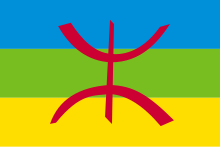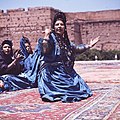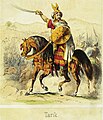بربرلر
ظاهر
(بربرلر-دن يوْللاندیریلمیش)
| Imazighen / ⵉⵎⴰⵣⵉⵖⵏ | |
|---|---|
 The Berber ethnic flag | |
| اهالی ساییسی | |
| 25 - 30 million[۱] – +70 million[۲][۳][۴][۵] | |
| چوْخلی اهالی اولان بؤلگهلر | |
| from ≈ 14 million[۳] to ≈ 20 million[۶][۷][۸][۹] or 27,078,593[۲] | |
| ~3,850,000[۲] | |
| 110,000[۱۰] or >6,589,652[۲] | |
| more than 2 million[۱۱] | |
| 2,883,000 (2,768,000[۱۲] & 115,000[۱۳]) | |
| 1,620,000[۱۴] | |
| 850,000[۱۵] | |
| 50,000[۱۶] | |
| 34,000[۱۷] or 1,826,580[۲] | |
| 37,060 (Including those of mixed ancestry)[۱۸] | |
| 3,500[۱۹] | |
| دیللری | |
| بربر دیلی (Tamazight), traditionally written with Tifinagh alphabet (mother tongue), also Berber Latin alphabet (adopted script); Maghrebi Arabic dialects (among Arabized Berbers) | |
| دینلری | |
| Predominantly Islam (سونیلر, شیعه, اباضیه); Small minorities adhere to Christianity,[۲۰][۲۱] Judaism and traditional faith | |
| مربوط اولان قومی قروپلار | |
| آفروآسیا دیللری[۲۲][۲۳][۲۴][۲۵][۲۶][۲۷][۲۸] | |
بربرلر (اینگیلیسیجه: Berbers، عربجه: أمازيغ، آنادولو تورکجهسی: Berberiler، فارسجا: قوم بربر) — بیر اتنیک قوروپو. بَربَر قدیم زامانلارین تعریفین ده بیر خالقا دئیرمیشلَر کی فرهنگ یا کولتور لحاظیندان هئچ بیر شِیء دوشونمورموشلار. اونلارين گؤردوگو ایش فقط دؤیوش، آدام اؤلدؤرمَگ و غارت ائتمَگیمیش.
آمّا سونرالیقدا هِلّاس (hellas) کولتورونده و یونانی ادیبلری بو تعریفی دئیشدیلر و او کسلَری بربر خیطاب اِلَرمیشلَر کی یونان یئرینده دونیایه گلمَهمیشدیلر.
ژرمانیاییلر، گاللار، داسیلر، تراسیلر، بربر مردؤمو و حتی بعضا ایرانئن قدیم پادشاهیلَرینده کی اؤزلرین گؤرا کولتؤرلَری واریمیش یونانیلر و رومیلر توسؤطیله بربر خطاب اولوبلار.[۲۹]
گؤرونتولر
[دَییشدیر]-
----------->
قایناقلار
[دَییشدیر]- ^ North Africa's Berbers get boost from Arab Spring. Fox News (5 May 2012). یوْخلانیلیب8 December 2013.
- ^ ۲٫۰ ۲٫۱ ۲٫۲ ۲٫۳ ۲٫۴ Tej K. Bhatia, William C. Ritchie (2006). The Handbook of Bilingualism. John Wiley & Sons. p. 860. ISBN 0631227350. 16 July 2016-ده یوخلانیب.
{{cite book}}: CS1 maint: uses authors parameter (link) - ^ ۳٫۰ ۳٫۱ Berber people.
- ^ Native Peoples of the World: An Encyclopedia. Ed. Steven L. Danver, M. E. Sharpe/Mesa Verde Publishing, 2013, p. 23f.
- ^ Berbers: The Empire Without Borders on temehu.com.
- ^ قایناق خطاسی برچسب
<ref>نامعتبر؛ متنی برای ارجاعهای با نامminorityrights.orgوارد نشده است - ^ Peter Prengaman: Morocco's Berbers Battle to Keep From Losing Their Culture / Arab minority forces majority to abandon native language, Chronicle Foreign Service, March 16, 2001, on sfgate.com.
- ^ قایناق خطاسی برچسب
<ref>نامعتبر؛ متنی برای ارجاعهای با نامaxl.cefan.ulaval.caوارد نشده است - ^ Sandy Donovan: Teens in Morocco. Compass point books, Minneapolis 2008, p. 42 (online version).
- ^ Tunisia. The World Factbook.[دائمی اولو باغلانتیلی]
- ^ Les langues de France : un patrimoine méconnu, une réalité vivante Archived 2014-09-29 at the Wayback Machine., originally published by CultureCommunication.gouv.fr.
- ^ Scholastic Library Publishing (2005). Lands and Peoples: Africa. Grolier. p. 135. ISBN 0717280241. 17 August 2016-ده یوخلانیب.; Moors 80% of population of 3,460,000
- ^ Joshua Project. Tuareg, Tamasheq in Mauritania.
- ^ Niger. The World Factbook. آرشیولنیب اصلی نۆسخهدن on 2020-04-24. یوْخلانیلیب2018-04-18.
- ^ Mali. The World Factbook. آرشیولنیب اصلی نۆسخهدن on 2015-11-10. یوْخلانیلیب2018-04-18.
- ^ Joshua Project. Tuareg, Tamasheq in Burkina Faso.
- ^ Joshua Project. Berber, Siwa in Egypt.
- ^ [۱]
- ^ Moshe Shokeid: The Dual Heritage: Immigrants from the Atlas Mountains in an Israeli Village. Manchester University Press, 1971.
- ^ Believers in Christ from a Muslim Background: A Global Census | Duane A Miller Botero - Academia.edu. academia.edu. یوْخلانیلیب27 March 2016.
- ^ *(فرانسهجه) Sadek Lekdja: Christianity in Kabylie, Radio France Internationale, 7 mai 2001 Archived 2017-10-18 at the Wayback Machine..
- ^ Blench, Roger. Archaeology, Language, and the African Past. Rowman: Altamira, 2006 آیاسبیان 9780759104662
- ^ Diakonoff, Igor. The Earliest Semitic Society: Linguistic Data. Journal of Semitic Studies, Vol. 43 Iss. 2 (1998).
- ^ Shirai, Noriyuki. The Archaeology of the First Farmer-Herders in Egypt: New Insights into the Fayum Epipalaeolithic and Neolithic. Leiden University Press, 2010. آیاسبیان 9789087280796.
- ^ Blench R (2006) Archaeology, Language, and the African Past, Rowman Altamira, آیاسبیان 0-7591-0466-2, آیاسبیان 978-0-7591-0466-2, books.google.be/books?id=esFy3Po57A8C
- ^ Ehret C, Keita SOY, Newman P (2004) The Origins of Afroasiatic a response to Diamond and Bellwood (2003) in the Letters of SCIENCE 306, no. 5702, p. 1680 doi:10.1126/science.306.5702.1680c
- ^ Bender ML (1997), Upside Down Afrasian, Afrikanistische Arbeitspapiere 50, pp. 19-34
- ^ Militarev A (2005) Once more about glottochronology and comparative method: the Omotic-Afrasian case, Аспекты компаративистики - 1 (Aspects of comparative linguistics - 1). FS S. Starostin. Orientalia et Classica II (Moscow), p. 339-408. http://starling.rinet.ru/Texts/fleming.pdf Archived 2020-12-07 at the Wayback Machine.
- ^ https://en.m.wikipedia.org/wiki/Barbarian























